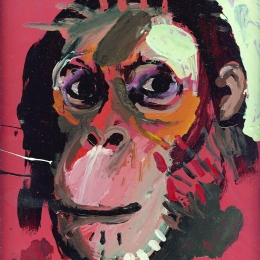art or business
Attila Stark: Tratatart
For Attila Stark graphic design is more than a mere profession; it is a form of artistic expression. Whether it is a publication design, canvas or wall surface in the street, his compositions are characterised by the same artistic qualities: creativity, spontaneity, decorativity, figural compositions and, often narrative components. His paintings are constructed from the motifs of his self-created world: Kulocity, modelled after an overcrowded, loud, filthy Budapest, is home to Jani Kula, the artist who tries to maintain his balance between the social and emotional adversities of everyday life. He likes to go out with his friends, but he make them and the people around them –including himself- appear like animals, mostly monkeys and monsters. This reflects on us as an ironic critique: in the eyes of the artist, we are either simply laughable or downright scary. Although he does engage in preliminary studies for his art pieces, in painting, he breaks free from any contrains and allows the creative process to take over. He uses spontaneous compositional techniques for depicting life situations, and thus the work assume the form of self-documentation. In addition to the dynamic brushstrokes, dribbles, splashes, he also engraves, writes, draws and glues things on the surface and leaves the traces of corrections plainly visible.
A study trip to Barcelona in 2002 had considerable and influence on this young artist in a number of ways. It was at this time that he began using enamel paint whose vibrant colours lure the viewer to the painting. The street art culture flourishing in the city was another key experience for him. The striking, colourful, figural and textual compositions slowly seeped from the walls over to the canvas, and, finally, ended up in the galleries. Attila Stark has been a returning artist featured at the group exhibitions of the kArton Gallery, where, in 2007, he also had a solo show. Just as a street artist who fits his work to the given context of public spaces, Stark also often incorporates into his pieces and defects and deformities of raw materials found in the streets.
He derives his narrative components from another „widling” of art: comics. In addition to caption bubbles, movement lines, sound waves and other signs, the painted scenes are rendered more complex by words in Hungarian and other languages, musical references and short comments. His own comics, which was also his diploma work in 2005 (basically a kind of graphic journal therapy created during his student years), was published thanks to Hungary’s „comics hunger”, and thus has become avaible to everyone. It contains a more complete unfolding of Jani Kula’s private mythology, and, upon becoming familiar with the journal, his paintings also become more „readable”. With the fresh, somewhat raw visual appeal of his ephemeral street installations, his unique publication designs and exhibitions, Attila Stark has seized not only the subcultural, but also the institutional, strongholds of art.

